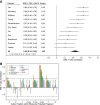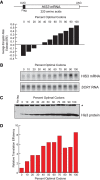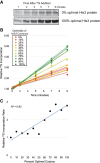Translation elongation and mRNA stability are coupled through the ribosomal A-site
- PMID: 29997263
- PMCID: PMC6140462
- DOI: 10.1261/rna.066787.118
Translation elongation and mRNA stability are coupled through the ribosomal A-site
Abstract
Messenger RNA (mRNA) degradation plays a critical role in regulating transcript levels in eukaryotic cells. Previous work by us and others has shown that codon identity exerts a powerful influence on mRNA stability. In Saccharomyces cerevisiae, studies using a handful of reporter mRNAs show that optimal codons increase translation elongation rate, which in turn increases mRNA stability. However, a direct relationship between elongation rate and mRNA stability has not been established across the entire yeast transcriptome. In addition, there is evidence from work in higher eukaryotes that amino acid identity influences mRNA stability, raising the question as to whether the impact of translation elongation on mRNA decay is at the level of tRNA decoding, amino acid incorporation, or some combination of each. To address these questions, we performed ribosome profiling of wild-type yeast. In good agreement with other studies, our data showed faster codon-specific elongation over optimal codons and faster transcript-level elongation correlating with transcript optimality. At both the codon-level and transcript-level, faster elongation correlated with increased mRNA stability. These findings were reinforced by showing increased translation efficiency and kinetics for a panel of 11 HIS3 reporter mRNAs of increasing codon optimality. While we did observe that elongation measured by ribosome profiling is composed of both amino acid identity and synonymous codon effects, further analyses of these data establish that A-site tRNA decoding rather than other steps of translation elongation is driving mRNA decay in yeast.
Keywords: codon optimality; decoding; mRNA decay; translation elongation.
© 2018 Hanson et al.; Published by Cold Spring Harbor Laboratory Press for the RNA Society.
Figures





Similar articles
-
Translation and mRNA Stability Control.Annu Rev Biochem. 2023 Jun 20;92:227-245. doi: 10.1146/annurev-biochem-052621-091808. Epub 2023 Mar 31. Annu Rev Biochem. 2023. PMID: 37001134 Review.
-
Codon optimality is a major determinant of mRNA stability.Cell. 2015 Mar 12;160(6):1111-24. doi: 10.1016/j.cell.2015.02.029. Cell. 2015. PMID: 25768907 Free PMC article.
-
Distinct elongation stalls during translation are linked with distinct pathways for mRNA degradation.Elife. 2022 Jul 27;11:e76038. doi: 10.7554/eLife.76038. Elife. 2022. PMID: 35894211 Free PMC article.
-
Not1 and Not4 inversely determine mRNA solubility that sets the dynamics of co-translational events.Genome Biol. 2023 Feb 20;24(1):30. doi: 10.1186/s13059-023-02871-7. Genome Biol. 2023. PMID: 36803582 Free PMC article.
-
Codon optimality, bias and usage in translation and mRNA decay.Nat Rev Mol Cell Biol. 2018 Jan;19(1):20-30. doi: 10.1038/nrm.2017.91. Epub 2017 Oct 11. Nat Rev Mol Cell Biol. 2018. PMID: 29018283 Free PMC article. Review.
Cited by
-
Dynamics of mRNA fate during light stress and recovery: from transcription to stability and translation.Plant J. 2024 Feb;117(3):818-839. doi: 10.1111/tpj.16531. Epub 2023 Nov 10. Plant J. 2024. PMID: 37947266 Free PMC article.
-
A comparative genomics-based study of positive strand RNA viruses emphasizing on SARS-CoV-2 utilizing dinucleotide signature, codon usage and codon context analyses.Gene Rep. 2021 Jun;23:101055. doi: 10.1016/j.genrep.2021.101055. Epub 2021 Feb 17. Gene Rep. 2021. PMID: 33615042 Free PMC article.
-
Decapping factor Dcp2 controls mRNA abundance and translation to adjust metabolism and filamentation to nutrient availability.Elife. 2023 Jun 2;12:e85545. doi: 10.7554/eLife.85545. Elife. 2023. PMID: 37266577 Free PMC article.
-
mRNA and tRNA modification states influence ribosome speed and frame maintenance during poly(lysine) peptide synthesis.J Biol Chem. 2022 Jun;298(6):102039. doi: 10.1016/j.jbc.2022.102039. Epub 2022 May 17. J Biol Chem. 2022. PMID: 35595100 Free PMC article.
-
The Ccr4-Not complex monitors the translating ribosome for codon optimality.Science. 2020 Apr 17;368(6488):eaay6912. doi: 10.1126/science.aay6912. Science. 2020. PMID: 32299921 Free PMC article.
References
Publication types
MeSH terms
Substances
Grants and funding
LinkOut - more resources
Full Text Sources
Other Literature Sources
Molecular Biology Databases
